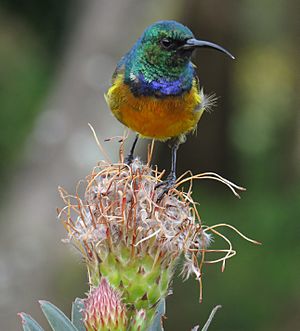Orange-breasted sunbird facts for kids
Quick facts for kids Orange-breasted sunbird |
|
|---|---|
 |
|
| Conservation status | |
| Scientific classification | |
| Genus: |
Anthobaphes
|
| Species: |
violacea
|
| Synonyms | |
|
|
The orange-breasted sunbird (Anthobaphes violacea) is a small, colorful bird. It is the only member of its special bird group, called a genus, named Anthobaphes. Sometimes, scientists also place it in another group called Nectarinia. This beautiful sunbird lives only in the southwestern part of South Africa. You can often spot it in parks and gardens there.
Contents
Meet the Orange-Breasted Sunbird
The orange-breasted sunbird is known for its bright colors. The males are especially striking. They have a shiny green head and throat. Their chest is a vibrant orange. This color fades into a yellow belly. Females are usually less colorful. They have a duller green-grey head. Their underparts are a pale yellow. Both male and female birds have a long, curved beak. This beak is perfect for reaching nectar.
Where Do They Live?
These sunbirds are endemic to southwestern South Africa. This means they are found nowhere else in the world naturally. They prefer areas with fynbos. Fynbos is a type of natural shrubland. It has many unique plants. These plants provide the birds with food. You can also find them in gardens. They visit parks and gardens in cities. This is because these places often have flowers.
What Do They Eat?
Orange-breasted sunbirds mainly eat nectar. Nectar is a sweet liquid. It is found inside flowers. They use their long, thin beaks to sip it. Their tongue is also specially shaped. It helps them collect the nectar. They also eat small insects. Insects provide them with protein. They might catch insects in the air. Or they pick them off plants. This varied diet keeps them healthy.
Life Cycle and Reproduction
Sunbirds build small, neat nests. They often hide their nests in bushes. The female bird usually builds the nest. She uses plant material. This includes twigs and grass. She lines it with soft things. This could be spider webs or plant down. The female lays one or two eggs. Both parents help feed the chicks. The chicks grow quickly. They leave the nest when they are ready.
Conservation Status
The orange-breasted sunbird is listed as "Least Concern." This means it is not currently endangered. However, its habitat is important. The fynbos areas are special. Protecting these areas helps the birds. It ensures they have places to live. It also ensures they have enough food. People can help by planting native flowers. This provides food for sunbirds.
Images for kids
See also
- Sunbird
- Birds of South Africa
- In Spanish: Suimanga pechinaranja para niños



